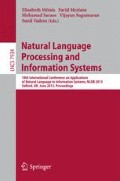Abstract
The work described in this paper is about the automatic detection and extraction of causal relations that are explicitly expressed in Modern Standard Arabic (MSA) texts. In this initial study, a set of linguistic patterns was derived to indicate the presence of cause-effect information in sentences from open domain texts. The patterns were constructed based on a set of syntactic features which was acquired by analyzing a large untagged Arabic corpus so that parts of the sentence representing the cause and those representing the effect can be distinguished. To the best of researchers knowledge, no previous studies have dealt this type of relation for the Arabic language.
Access this chapter
Tax calculation will be finalised at checkout
Purchases are for personal use only
Preview
Unable to display preview. Download preview PDF.
References
Khoo, C.S.G., Kornfilt, J., Oddy, R.N., Myaeng, S.H.: Automatic extracting of cause-effect information from newspaper text without knowledge-based inferencing. Literary and Linguistic Computing 13(4), 177–186 (1988)
Carcia, D.: COATIS, an NLP System to Locate Expressions of Actions Connected by Causality Links. In: Plaza, E., Benjamins, R. (eds.) EKAW 1997. LNCS, vol. 1319, pp. 347–352. Springer, Heidelberg (1997)
Ittoo, A., Bouma, G.: Extracting Explicit and Implicit Causal Relations from Sparse, Domain-Specific Texts. In: Muñoz, R., Montoyo, A., Métais, E. (eds.) NLDB 2011. LNCS, vol. 6716, pp. 52–63. Springer, Heidelberg (2011)
Sadek, J., Chakkour, F., Meziane, F.: Arabic Rhetorical Relations Extraction for Answering "Why" and "How to" Questions. In: Bouma, G., Ittoo, A., Métais, E., Wortmann, H. (eds.) NLDB 2012. LNCS, vol. 7337, pp. 385–390. Springer, Heidelberg (2012)
Haskour, N.: Al-Sababieh fe Tarkeb Al-Jumlah Al-Arabih. Aleppo University (1990)
Author information
Authors and Affiliations
Editor information
Editors and Affiliations
Rights and permissions
Copyright information
© 2013 Springer-Verlag Berlin Heidelberg
About this paper
Cite this paper
Sadek, J. (2013). Automatic Detection of Arabic Causal Relations. In: Métais, E., Meziane, F., Saraee, M., Sugumaran, V., Vadera, S. (eds) Natural Language Processing and Information Systems. NLDB 2013. Lecture Notes in Computer Science, vol 7934. Springer, Berlin, Heidelberg. https://doi.org/10.1007/978-3-642-38824-8_48
Download citation
DOI: https://doi.org/10.1007/978-3-642-38824-8_48
Publisher Name: Springer, Berlin, Heidelberg
Print ISBN: 978-3-642-38823-1
Online ISBN: 978-3-642-38824-8
eBook Packages: Computer ScienceComputer Science (R0)

